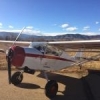
Wing Tank replacement - ALMOST-
Started by
rdooley79,
34 posts in this topic
Create an account or sign in to comment
You need to be a member in order to leave a comment

Started by
rdooley79,
You need to be a member in order to leave a comment